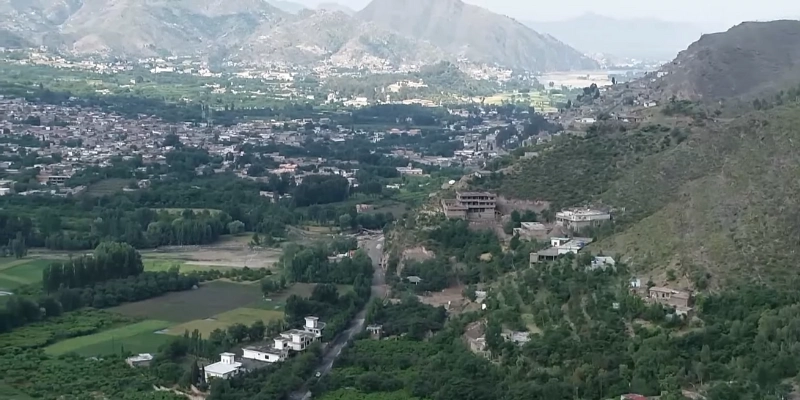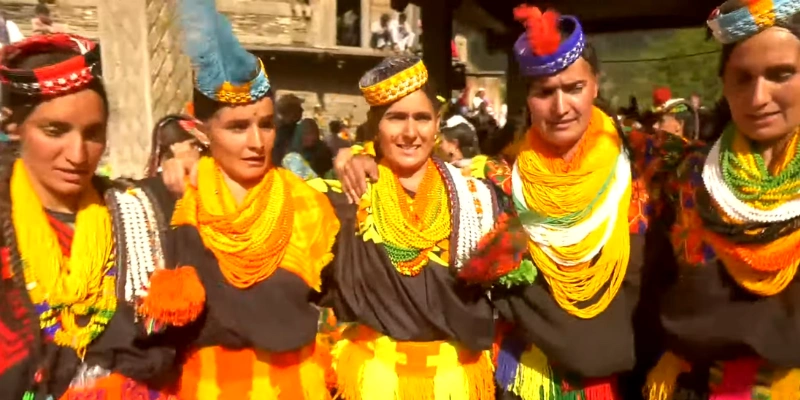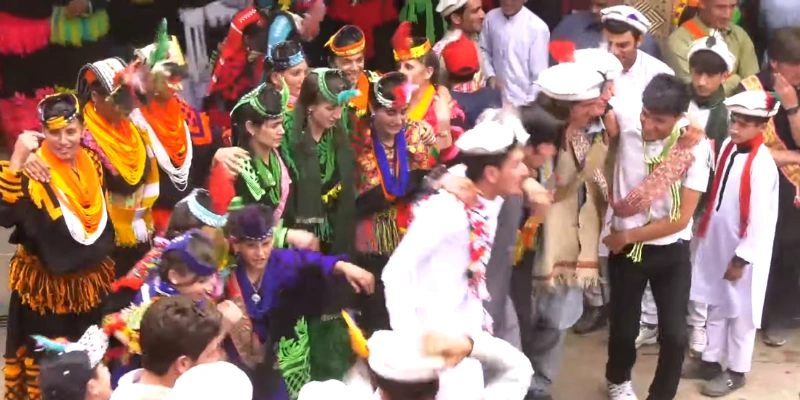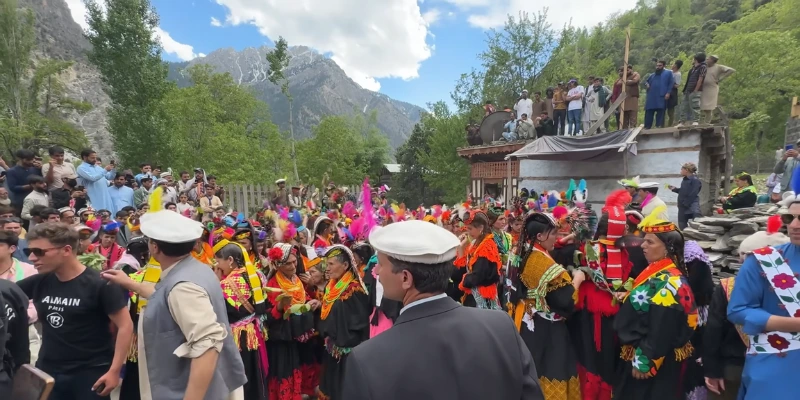Chilam Joshi Festival in Kalash Valley – A Colorful Spring Celebration
Published: 29/05/2025
Have you ever heard of a festival where people dance in circles, wear bright clothes, and celebrate love, spring, and nature? Welcome to the Chilam Joshi Festival in the beautiful Kalash Valley of Pakistan. People also call it the Joshi Festival. It’s a lively event filled with colors, music, traditions, and happiness.
Held every year from May 13 to May 17, Chilam Joshi marks the arrival of spring when snow melts from the mountains and flowers bloom. It’s a time for the Kalash people to pray for good crops, happy animals, and strong community ties.
Let’s explore this exciting cultural event!
About Kalash Valley
Kalash Valley is a peaceful and scenic place in northern Pakistan, near Chitral. It is home to the Kalash tribe, a unique group of people with their own culture, language, and traditions. The Kalash people live in three major valleys: Bumburet, Rumbur, and Birir.
The Kalash people are known for their colorful clothes, kind hearts, and love for festivals. They welcome tourists but expect respect for their customs.

Where and When Does It Happen?
- Dates: Every year from May 13 to May 17, when the mountains start to warm up and the snow melts.
- Location: Kalash Valley, in the valleys of Bumburet (including villages like Aneesh, Bron, Karakal, and Patrik), Rumbur, and Birir.
- How to Get There: You can reach the valleys from Chitral (2–2.5 hours) or Dir (4–5 hours) by jeep or van. The roads are bumpy and unpaved, so be ready for a bit of an adventure! You’ll pass security checkposts and might need to switch vehicles at an old bridge under construction.
What Makes the Chilam Joshi Festival So Special?
The Chilam Joshi Festival is like a big party that mixes fun, tradition, and spirituality. Here are the highlights:
1. Bright Clothes and Lively Dances
The Kalash people wear beautiful, colorful outfits that make the valleys look like a rainbow. Women dress in black robes with bright embroidery and special headgear, while men wear woolen clothes.
They gather in circles for jhoomi dances, moving to the beat of drums and flutes. These dances and songs are very old, passed down through generations, and fill the air with joy.

2. Special Rituals
One unique tradition is the Makh Soos ritual. Babies born in the past year are bathed in milk before they can enter the community’s worship places. This happens at different times in each valley, Rumbur, Bumburet, and Birir.
Another special part is communal marriages. Young men and women can choose their partners freely, often holding walnut branches and leaves during separate gatherings. There’s no divorce in Kalash culture; women can leave one partner for another if they agree.
Some even marry Muslim men with consent. During marriages, a goat is sometimes sacrificed, and the meat is shared with everyone.

3. Delicious Food and Warm Hospitality
The Kalash love sharing their food with visitors. You can try thick chapatis, black tea with milk, and fresh fruits like mulberries, pomegranates, and apricots. Locals often give sweets to tourists, especially foreigners, as a kind gesture.
You might also taste Chapli Kebab made with Rahu fish or sip refreshing apricot juice.
4. A Celebration of Nature and Community
The festival celebrates the start of spring, when farming and animal care begin. The Kalash pray for good crops and healthy livestock, making this a time of hope and togetherness.
It’s one of their biggest festivals, along with Choimus (December 10–22), Uchal (August 21–22), and Pro (only in Birir Valley).

Who Are the Kalash People?
Around 4,000 Kalash people live in nearly 30 villages scattered throughout the Kalash Valley. They are not Muslim and have their own unique culture, language, and traditions. They’re known for being kind and welcoming, but they ask visitors to respect their way of life. Some Kalash, like Salahuddin Bhai, have converted to Islam but still share traditions with their neighbors.
Women play a big role in the community, working in fields with crops like cardamom, cutting sandalwood, and cooking. There’s a special place called loot, loot, where women stay for six days after giving birth. The Kalash also value education, with kids learning Urdu and computer basics at a local primary school.
Their homes are built into the mountains, surrounded by streams, flowers, and mulberry trees. They have unique burial practices, too; coffins are now placed underground to prevent theft, unlike older traditions.

Why Visit Chilam Joshi?
Tourists love the Chilam Joshi Festival for its vibrant energy and the stunning beauty of Kalash Valley. Here’s what you can enjoy:
- Watch the Fun: See Jhoomi dance and hear traditional music at the festival ground, just a 10-minute walk from a nearby lane.
- Eat Local Foods: Try chapatis, tea, and fish kebabs, or buy fresh fruits.
- Shop for Souvenirs: Pick up handmade shawls or carved wooden items.
- Enjoy Nature: The valleys are surrounded by mountains, rivers, and snow, perfect for photos.
During the festival nights, the Kalash say fairies come out to dance, making the celebration feel truly magical!
How to Plan Your Visit
Planning a trip to the Chilam Joshi Festival in Kalash Valley is an exciting adventure! This vibrant spring celebration is full of color, culture, and unforgettable moments. Here’s a simple guide to help you get ready for your visit from May 13 to May 17.
Getting There
- Fly to Islamabad, then take a bus or car to Chitral.
- From Chitral, hire a jeep to reach the valleys (2–2.5 hours). The roads are rough, so bring motion sickness pills if needed.
- The festival site is just a quick 10-minute walk from a nearby lane.
Where to Stay
- Stay in guesthouses in Bumburet, Rumbur, or Birir.
- Book hotels in Chitral for more comfort, but reserve early as places fill up fast during the festival.
Packing Tips
- Bring warm clothes for chilly nights.
- Pack comfortable shoes for walking.
- Bring cash with you, as there are no ATMs available in the valley.
- Bring a reusable water bottle and a camera (but ask before taking photos).
| Important Tips for Visitors |
|---|
|
To have a great time and respect the Kalash, follow these tips:
|
Challenges to Know About
While Chilam Joshi is amazing, there are some challenges:
- Rough Roads: The trip to the valleys can take 1 hour and 32 minutes from Chitral due to bad roads. Promises to fix them haven’t happened yet.
- Few Hotels: Limited places to stay can make it hard to find a room.
- Health Care: There are no proper clinics, so bring any medicines you need.
- Tourist Behavior: Some visitors film without asking, which upsets locals, especially women.
- Small Community: The Kalash population, once over 50,000, is now only 4,000. Too many tourists can disturb their traditions.
To help, the government could build better roads or create trekking areas to spread out visitors and protect Kalash culture.
Why You Should Go
So, guys, in this article, we’ve covered the Chilam Joshi Festival in Kalash Valley in detail. From the colorful jhoomi dances to the warm hospitality of the Kalash people, this festival is a beautiful way to see a unique culture and enjoy the stunning mountains.
I recommend visiting during the festival to experience the music, taste local foods like chapatis and apricot juice, and meet the friendly locals. Just remember to respect their traditions!
Start planning your trip to Kalash Valley for May 13–17, and make memories you’ll never forget!
FAQs
Yes, the festival is generally safe for visitors. The Kalash people are very welcoming, but you should follow local rules. Check travel advice before going to stay prepared.
There are guesthouses in Bumburet, Rumbur, and Birir, but rooms fill up fast. Some tourists stay in Chitral and visit daily. Always book early to avoid last-minute stress.
Yes, tourists are welcome to watch and sometimes join in, especially the jhoomi dances. But always ask before participating and respect their space during rituals. The Kalash people are friendly but value their traditions.
Yes, but always ask permission before taking photos, especially of women. Respecting privacy is important to the Kalash. A polite request makes everyone happy.
You can enjoy thick chapatis, black tea with milk, and Chapli Kebab made with Rahu fish. Fresh fruits like pomegranates and apricots are also delicious. Locals may offer sweets as a kind gesture.
Yes, tourists are welcome to watch and sometimes join in, especially the jhoomi dances. But always ask before participating and respect their space during rituals. The Kalash people are friendly but value their traditions.
The mobile network is weak in Kalash Valley. Don’t expect fast internet or reliable calls. Let your family know you might be hard to reach.
The festival area is just a 10-minute walk from a nearby path. Reaching the valleys from Chitral takes around 2 to 2.5 hours by jeep. The roads are bumpy, so plan for extra time.
You can watch the Jhoomi dances, which are super fun to see. Sometimes, locals might invite you to join in. Always ask first and follow their lead to show respect.
It’s more than just a party, it’s about honoring nature, family, and love. They pray for good harvests and celebrate new life, marriage, and community strength. It’s one of the few times all three valleys come alive in shared joy!

- Be Respectful
- Stay Relevant
- Stay Positive
- True Feedback
- Encourage Discussion
- Avoid Spamming
- No Fake News
- Don't Copy-Paste
- No Personal Attacks

- Be Respectful
- Stay Relevant
- Stay Positive
- True Feedback
- Encourage Discussion
- Avoid Spamming
- No Fake News
- Don't Copy-Paste
- No Personal Attacks



